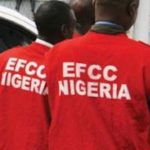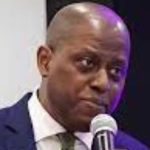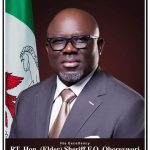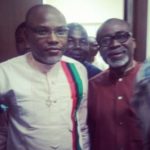How USPF is creating telecom access, by Maikano
 Abdullahi Maikano is the Secretary of the Universal Service Provision Fund (USPF) in the Nigerian Communications Commission (NCC). Recently he spoke to some journalists on the new focus of the Fund and efforts to bring telecom services to rural Nigerians. Excerpts.
Abdullahi Maikano is the Secretary of the Universal Service Provision Fund (USPF) in the Nigerian Communications Commission (NCC). Recently he spoke to some journalists on the new focus of the Fund and efforts to bring telecom services to rural Nigerians. Excerpts.
Rebranding the USPF
The EVC of the NCC has already started talking about some of the things we’re doing; one of the first things we did is to rebrand the Universal Service Provision Fund, USPF, and over the next few weeks to one month, maybe you’ll start seeing the new face of the USPF. So we did rebranding and also refined our processes and strategies. What we did was to look at what we’re doing from two perspectives only, and this is consistent with the mandate that created us. We’re dealing with connectivity, we’re supposed to provide connectivity and we also provide access. So anything we’re doing is either connectivity or access. In the past, we seemed to be doing things without actually defining what they are; all we just need is connectivity.
Areas of focus
There is this term now, that is, Bring Your Own Device, BYOD. People want connectivity so that they can access any service using their device. You have the platform that keeps you going; so we’re looking at it that way. On the other hand we also provide access, that means we provide any devices that can provide access to services. So we’ve streamlined the activities of the USPF to strictly focus on these two areas.
Going beyond Schools
In the past, 99 per cent of what the USPF has been doing is to provide access, not to individuals but to schools. Most people know USPF only as provider of computers to schools. The individual on the streets doesn’t know the USPF. The USPF activity does not affect him, so we’re breaking from this tradition. We’ll still continue to provide computers to schools because we’ve seen it’s something good, but we’re trying to ensure that it results in providing the right impact. But the break in tradition is that we’re coming up with projects that affect the individual on the street. We did an initial study that showed to us that even though about 120 – 130 million mobile phone lines are in this country; a country of over 160 million people. In terms of individuals less than 60 per cent of the population have phones. It’s not because they’re expensive, but because they don’t live where there is service.
Better Life for Rural Dwellers
If you remember, over 60 per cent of the population live in the rural areas. So what we try to do is to design a strategy that makes sure that these people get service; we’re not going to be operators but what we did was to identify places, communities, villages and towns where there is no service and we created clusters of those places that we’re partnering with mobile operators to ensure that service is expanded to these communities as quickly as possible. They will pay the same price we pay in the city; we will lower the entry levels to the operators so that this people can get service. Then the activity of the USPF is felt by the ordinary man on the street; this is one break in tradition.
Broadband for all…
The second break in tradition is that we said we’re in the age of broadband and if you remember the theme of the CTO was ‘Innovation through Broadband’; and broadband is not for you and me alone, it’s for everybody; it must be inclusive, because of that we try to do two things; we’re providing subsidies to telecoms companies to deploy fibre optic cables to those places that currently don’t have. Even if you take mobile telephony today in most of those places the highest they can get is 3G, and with 3G you can’t have an experience of broadband. For you to have a broadband experience you have to have a fibre optic cable extended to those areas. These operators will not do it now because there’s no guarantee of Return on Investment. We’re again partnering with the operators to ensure that at least every local government area is within the broadband infrastructure.
A break from the routine
The next thing is to have last mile and then you can give an individual who wants to have two megabytes when you start getting broadband experience. This is again a break in tradition because that will affect individuals; you don’t have to be in school before you can feel the impact of what USPF is doing. Currently, regarding this fibre optic, in the next one month we’ll be completing 500km that we’ve already provided subsidy for and we did a random calculation of the population that will benefit and that comes to about 15 million Nigerians will be within broadband service. All you need to do is subscribe to it because it is there. A lot of the businesses that are using satellite as a means of doing cashless banking and the likes will now provide those services because they actually have to get their services through fibre optic cables which means they can have huge capacity at lower cost, this is the break that we see.
Our strategy
The third thing we’re doing which will start having significant impact is that we said Nigeria is so huge and for you to intervene in a way that will be impactful you need two boxes. You can’t take Nigeria as one whole and begin to say you’re going to provide service. You need to be able to find a way to organise the country and we are currently creating clusters of all the areas that don’t have service. We’ll create clusters across the country and we’ll end up saying the number of clusters we have. Every year if we deal with two or three it means those clusters have been dealt with. We take each cluster and look at it from the point of view of the type of infrastructure available and what needs to be done so that you don’t do the same thing in two clusters.
Not all parts of the country are in the same state of development, what you may do in some clusters in the North might be different from what you’ll do in a cluster in the South or East. That way you don’t give people what they don’t need and then deny them what they want. It is one of those new things we are doing; at the end of the day the impact of what we’re going to do will be felt; you can see, smell and touch.
Details of subsidy and cost
I wouldn’t want to talk about figures because the subsidy is not normally a fixed amount. All the subsidies we give are competitive deployment. Like in one of the instances we have three operators that we’re providing subsidy to extend fibre optic services. I don’t want to name them at this point; we’re giving them across the six geo political zones, because they’re all competing you find none of them is receiving the same subsidy amount because we’re living in a competitive environment. For instance we’re expanding fibre optics to some parts of the North East, South South, South East, South West and parts of the North Central.
Rural and urban areas pricing
Yes, the pricing is going to be the same; the reason is that ideally they’ll want to charge higher in the villages because there are no sales. Where there is less demand for services it means ROI takes longer time; it takes longer time to make profit than in the city where demand is higher. When the demand is higher the price is lower and when the demand is less the price is higher. What we insist is that the grade of service is going to be the same, the quality of service you’re going to get anywhere you are is the same, how much you pay is also going to be the same; that is more logical. Ideally it will be more expensive for you in a remote village than when it is in Lagos; that is typical with most services.
Any operator that takes service to rural community will tend to charge higher. We said okay we’re going to provide a bridging fund which is subsidy. Remember the Equalisation Fund of petroleum where the cost of a litre is the same across the country. But the cost of transporting a tanker from Lagos to Sokoto and a tanker from the ports in Lagos to Victoria Island in Lagos is different. Cost is therefore equalised so that you guarantee the same price; that is the idea.
Timelines and obligations
Yes there are timelines, obligations, penalties and also commitment to service quality. But I must say that those areas are still part of Nigeria and it will be foolhardy for me to expect an operator who probably will operate in the same environment where you have all those challenges that are making it impossible for them to provide optimal service in Abuja. They might tell you because there is insecurity, there’s no power or all sorts of things. We’re USPF, we’re not in charge of the telecom industry; all we’re trying to do is to get the poor quality service that we experience in Abuja everywhere. Those people also want the drop calls but they don’t have it. We want to give them the same drop call that we’re having which they don’t have.
All that we aim to do at this point is to make sure that everybody gets access fast, then the issue of ensuring that the service is world class will be dealt with. But if you tell the operators what they must do, they’ll tell you they’re not interested because they can’t meet it. For the operator to meet this it will take one year and we don’t want them to wait for another year without service. They would rather get the poor quality service and then work with us, manage it until they get it. This is the way we’re looking at it or else it will take a much longer time. By the way if you’re talking about mobile telephony, only a few days ago we were talking with the EVC and some other people from the US, they were saying one of the operators was in a part of America and couldn’t get 3G on his mobile phone. Because it is wireless it is at the mercy of the weather. Simple weather will affect the signal. We want services to be everywhere then we can deal with the other issues.
Maintenance of services in rural areas
Currently, we’re targeting to support the deployment of about 100 base stations across the country. It is a huge number, comparing the fact that maybe in the past we did about 59, so if in one year we’re able to support the deployment of 100, that’s a good record.The strategy we’re adopting to do this is to provide subsidies to those operators that are going to use solar or from solar to hybrid. If you can use generator, solar, hybrid power with any other sources of energy then the cost of deploying that particular base station will be high. But we’re ready to provide subsidy, so that way it guarantees sustainability and cost of maintaining those particular base stations will be low, you spend less in diesel and we insist on the use of hybrid in most areas in the Southern part because you don’t get much sun there. So you need to have a kind of solution that is a mix of public power, generator and solar cell so that everything there can now store that power and use it. But in the North if you’re just using solar and generator only that will be okay because a lot of time you’ll have sun that you can actually store to the extent that you’ll use less diesel. The cost of operating that site is going to be low.
Dialogue with Operators
From the discussions we had with the operators, because we did industry consultation some months ago, one of the issues identified was the cost of maintaining those sites. Not even the cost of installing, but operating. If you use N30 million to build a BTS, you’re using maybe N2 million every month to operate it, you had better be getting N5 million from that particular BTS. If you’re not getting up to N3-5 million monthly then you’re operating at a loss.
If you use renewable energy like solar or any other energy beyond diesel then the cost of operating that particular site will be minimal even if you have only a few subscribers connected to it; over time you’ll begin to make profit because you don’t expect to get the cost of that installation over one year, you’re supposed to spread it because it’s a fixed cost. So there’s a minimum amount below which it will be a loss. And they’ve shown us a number of sites that they’ve commissioned because it’s not profitable for them to operate there and they don’t want to deploy those other renewable energy solutions because they’re very expensive. If we can come in and partner with them to bring down the entry level, they’re ready to come in because at the end of the day operating those sites will be something affordable. With the design that we did you must deploy using at least solar power.
Projects completion
Our operational year is not January to December; we operate between July and June. We’re expecting that by June next year we’ll commission some of these projects. We’re expecting to commission the rural broadband because we’re already testing it in some of the sites that we have provided subsidy. Rather than using individuals to test it we have schools that we have provided computers and internet connectivity using satellite. We ask the company that we’re partnering with to provide wireless broadband service to those schools; at least two schools in each of these areas. At the moment we have about 10 schools with which we’re testing and we’re expecting that by the time the test is successful we’ll formally launch it and the people will start seeing that the service is actually available, not mainly for schools but for everybody. You can just get service, connect your mobile phone because most phones are internet ready.
Wiring the Universities
We’re also commissioning the 500km fibre optic that we’ve also provided subsidy for. I think our clusters will also be ready about that same time. I omitted the inter -campus connectivity in the universities. In the universities in the past what we used to do is that we provide computers but we’ve discovered that computers are not what the universities are looking for; they have it. The students have computer and laptops better than the ones we want to give them, what they need is the connectivity; they need a Bring Your Own Devices environment. We’re working closely with NUC; we’re connecting all the universities together with fibre. The first set of universities we’re currently dealing with are 17 and we’re expecting that probably around June also we should be able to commission 5 or 6 among them because we’re not only connecting them with fibre but we’re providing end user devices like; video conferencing facility, data centres and we’re going to install in every university the IP 460.
University of Lagos Example
With the University of Lagos having its main campus in Akoka, the teaching hospital in Idiaraba, we’re going to connect the teaching hospital with fibre to Akoka, the main campus. We’re going to provide video conferencing facility, which means they can do video conferencing call. We’re going to put IP 460, which means that they won’t use mobile phone from Akoka. If the VC wants to talk to the Chief Medical Director, he’ll pick the intercom and make a voice call on IP to LUTH so any staff that wants to talk to the lecturer will just call. With my extension here in Abuja, I can call any of our staff in the zonal office in Kano because I’ll use IP. That is what we’re doing; we’re putting together voice, video, and data so they’ll have a tele-presence kind of thing. We intend to launch some of these in 3-5 universities around June also. Quite a lot of things we’ll be commissioning as well as the e-library we’re handing over in the next months.








